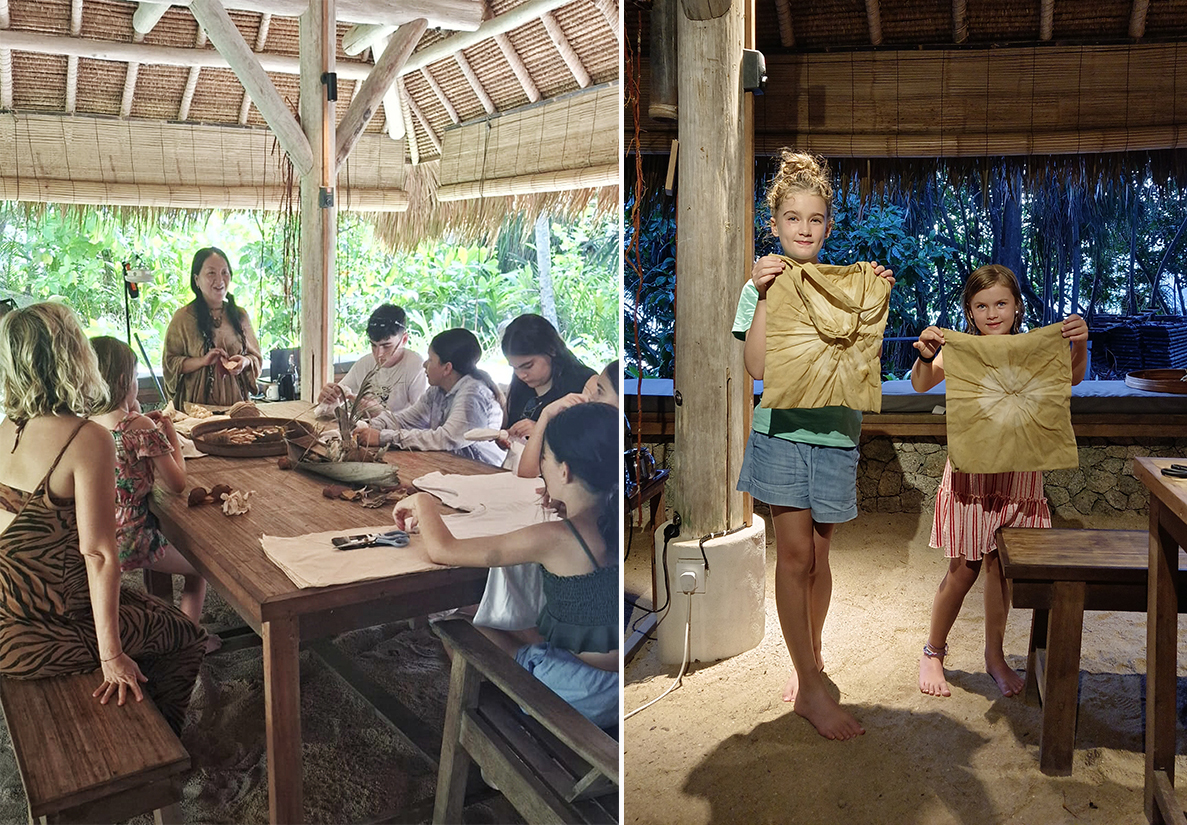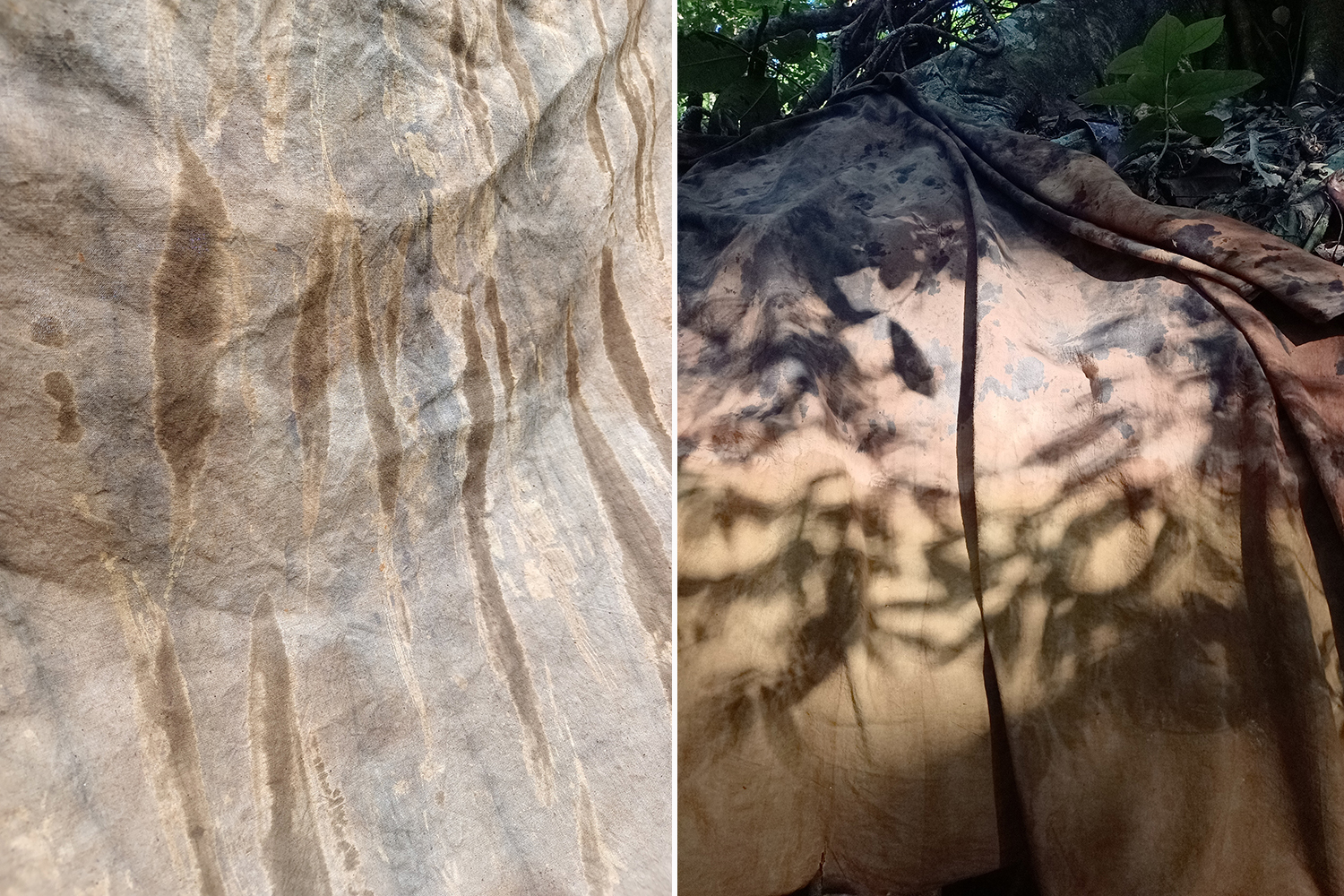

Ireen Tan is a textile artist based in Johor Bahru, Malaysia. Her creative journey has been deeply influenced by her upbringing. Growing up with her mother, a tailor, Ireen often played with fabric scraps, sparking her passion for experimenting with various media and materials in her artwork. She uses techniques such as weaving, natural dyeing, and macramé to convey her artistic ideas.
Ireen's love for exploration and connection with people through travel serves as a continuous source of inspiration and drives her creative process. Throughout her career, her work has been featured in notable publications, including Mina Malaysia, Eye Asia Magazine, The Charm, Juice Magazine, Going Places, the in-flight magazine of Malaysia Airlines, and Female Magazine.
Her notable projects include the "Weave Series" (2012) headpiece showcase at Eight Lido, Malaysia, and a woven tree branch installation at Sea and Saw in 2015. In 2016, she participated in the Feira de Arte de Tap Seac art market and forum in Macao, followed by her involvement in the "Hey, I'm Here" exhibition in Malaysia in 2017. She created the "Last Straw" art installation in collaboration with Medini Edible Park in October 2018 and engaged in the Aizome learning trip to Japan, sponsored by the Malaysia Beyond Iskandar Boundaries Program 2019. The same year, she held an Aizome Exhibition, shared her skills in a workshop, and collaborated with Malaysian singer-songwriter Zee Avi to craft handpieces. In 2020, she completed a tree branch weaving installation at Harmony Hub 7 in Pai, Thailand.
Ireen Tan's artistic practice reflects her unique background, passion for natural materials, and desire to foster connections through her art.
My primary goal for this residency is to research the island’s natural materials and conduct experiments with them—particularly in relation to natural dyeing. Beyond that, I aim to push the boundaries of my practice by utilising whatever resources I find to create works that go beyond dyeing, opening possibilities for new forms of expression and material exploration. This residency is both an artistic and ecological investigation, rooted in responsiveness to place and guided by curiosity.
In addition to material research and experimentation, I am also interested in promoting the idea of repurposing—specifically by giving a second life to used or worn-out items such as blankets and pillowcases found at the resort. By re-dyeing and reworking these textiles using local natural dyes, they could be transformed into something new and meaningful, perhaps even developed into merchandise that reflects the island’s identity and sustainable values. This initiative seeks to merge creativity, ecology, and circular design, encouraging a more thoughtful relationship between people and materials.

For my experiments during this residency, I worked with a range of natural materials sourced directly from Nikoi Island, including: Ketapang (Terminalia catappa), Sawo leaves (Sapodilla, known as Daun Ciku in Malaysia), sea pandan fruit (Pandanus tectorius), coconut palm root (Cocos nucifera), red mud (bauxite), coral bone, brown algae (Padina and Sargassum), and sea moss (Chondrus crispus).
Each material was processed through hot boiling extraction, and the resulting colours were modified using various mordants such as alum, iron, potassium, gallnut (tannin), and kapur (edible lime). I also conducted ph tests on the dye baths and mordant solutions to better understand how acidity or alkalinity affects the resulting colours and fibre reactions. This helped guide my adjustments and deepen my understanding of how local materials interact under different conditions.
One of my most exciting discoveries was working with brown algae, which I had never used before. When boiled, the algae produced a rich, earthy brown that shifted in hue depending on the mordant and pH levels applied. The interaction between the minerals and the natural pigment offered fascinating variations.
Another noteworthy experiment involved coral bone. Due to its high calcium content, I was curious to see how it would behave with cellulose fibres like cotton. Early results suggest it has the potential to act as a mineral-based modifier, adding new dimensions to natural dyeing techniques.
Despite its red appearance, sea moss did not yield any strong pigment when boiled. Instead, it transformed into a slimy, lime-green substance, which, while not useful for dye, shows promise as a biological material for yarn or textile innovation—perhaps as a base for future bio-yarn development.
Through these experiments, I’m not only expanding my understanding of island-based resources but also exploring new materials, testing methods, and creative processes that challenge the boundaries of natural dye and fiber art.
%20Algae%20(Sargassum)%20%20(right)%20Red%20Mud%20(Bauxite).jpg)




As part of this residency, I also conducted workshops for both resort guests and staff, aiming to foster creativity, environmental awareness, and a culture of repurposing.
My goal for the guests—especially children—was to plant a seed of curiosity about nature and its hidden potential. I led a Ketapang dye workshop, inviting participants to bring and re-dye their old T-shirts. I began by introducing the Ketapang tree (Terminalia catappa), which grows abundantly on the island. Though its leaves appear simply green at first glance, they can produce a surprising range of colours when processed. By sharing this, I hoped to awaken a sense of wonder in the children, encouraging them to look at everyday plants more closely and to imagine what other “secrets” nature might hold. At the same time, the workshop served as a gentle introduction to the idea of repurposing and reducing textile waste, an important conversation in the age of fast fashion.
For the resort staff, I offered a final workshop with a similar message, but tailored more toward practical application.Together, we explored how to repurpose old resort items—particularly used blankets and linens—through natural dyeing and simple tie-dye techniques using accessible tools like ropes and clips. The session was designed to share techniques and inspire creative reuse, encouraging staff to think about how these transformed materials might be reintegrated into the resort—whether as decor, amenities, or even merchandise.
My hope is that this exchange sparks a longer-term culture of sustainable creativity on the island, where natural resources and waste materials alike are seen not as limits, but as starting points for innovation.



Leaf Wave is a fabric installation displayed in the bar area of the resort. The choice of location is intentional—this space catches the natural sea breeze, allowing the installation to move gently with the wind, echoing the rhythm of the island. The fabric pieces were all hand-dyed using tie-dye techniques and Ketapang leaves (Terminalia Catappa), which I believe best represent the island’s colour palette. The movement and colour together create a quiet but powerful presence, inviting visitors to pause and feel the natural energy of the island.

I displayed textile samples from my dye experiments using natural resources on Nikoi Island outside the residency studio. Each fabric reflects a unique combination of materials, mordants, and techniques such as tie-dye and mordant drawing. The showcase serves as a visual diary of my process—capturing the potential of local plants, earth, and marine matter in fibre art.




The Coral Rattle was the first piece I created during the residency. It was inspired by a sensory experience while foraging along the coral beach—specifically the sound made when stepping on coral fragments. This sound sparked the idea of transforming coral remnants into a handheld instrument, highlighting the island’s auditory textures and the hidden creative potential of natural debris.

Nikoi Island has an abundance of coconuts, each with multiple uses. I repurposed coconut shell pieces, along with shells I found and naturally dyed fabric, to create a drawstring bag. The result is both aesthetically unique and functional, blending beauty with practicality and reinforcing the idea that sustainable materials can be transformed into meaningful everyday objects.

During my exploration, I discovered the creative potential of island plant fibers, particularly from driftwood twigs and dried sea pandan fruit. By selecting young fibers from the fruit and boiling them to soften the texture, I was able to craft brushes that work for both printing and painting on fabric. This experiment not only expanded my toolset but also emphasized the island’s untapped resources for artistic expression.
One word that stayed with me throughout this residency is "coexist"—both in the relationship between humans and nature, and among humans themselves.
In terms of human–nature coexistence, I was deeply moved by the sustainable philosophy practised on Nikoi Island. The team here goes to great lengths to maintain ecological balance, ensuring that flora and fauna can thrive in harmony with human presence. This commitment to living in balance with nature is not just inspiring—it's a real, tangible model of how coexistence can be practised, not just imagined. It reminded me that sustainability is not a trend but a long-term relationship of care and respect.
As for human–human coexistence, I felt incredibly enriched by the connections I made with the staff. They were not only my collaborators, but also my friends and teachers. For example, Mr. Yogi, the first person I met, generously shared his deep knowledge about plants. Amandine, the marine biologist, fed my curiosity with insights about marine life that I've longed to learn. Our canteen conversations with other stuff—ranging from nature to topics like history and religion—were truly food for thought, nourishing my inner life throughout the residency.
Working alongside Mr Marjan, Esme, Yudi, Rudi, and the rest of the team was equally fulfilling. Their sincerity, warmth, and willingness to help went beyond efficiency—they embodied a spirit of genuine kindness and support that I will always treasure.
Through both the natural world and the people here, I was able to experience the true meaning of coexistence—not just living alongside, but learning from, caring for, and growing with one another.
















